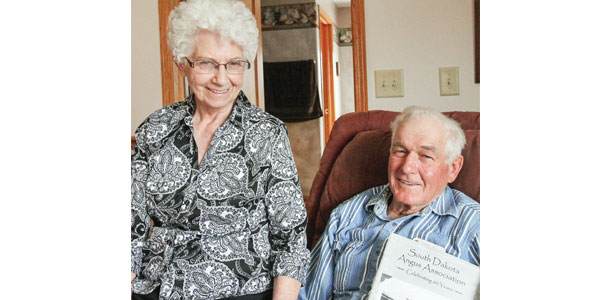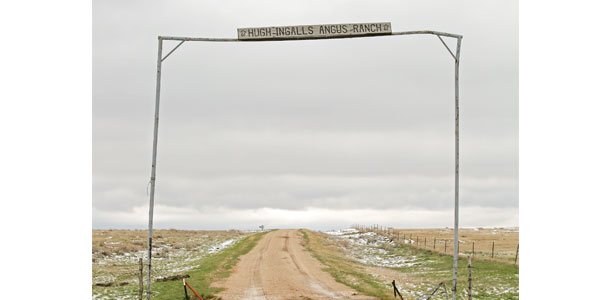“Bullheaded is the term I’d use,” his wife, Eleanor, adds. “The first winters for folks homesteading here a century ago were brutal. Because they were stubborn, they stayed.”
Hugh Ingalls’ father was 12 years old on a farm in eastern South Dakota when members of the family moved west to settle various 160-acre tracts of treeless prairie on the other side of the Missouri River.
Over 100 years later, Ingalls’ Centennial Angus Ranch is among South Dakota’s top 10 Angus breeders for registrations. Not surprising since Hugh has the state’s oldest Angus herd, dating back to a bull with a handwritten pedigree purchased from Illinois by Hugh’s grandfather in 1895.

Production records have been important to the genetic program ever since Hugh and Eleanor started ranching together in the 1950s at their current location near Faith. In 1983, their efforts were recognized with the American Angus Association Centennial Angus Herd Award.
The Ingalls Angus genetics are also recognized as high-quality and uniform. Half the males of the calf crop are sold as steers for beef quality research at South Dakota State University, and the other half as herd bulls private treaty at his annual spring sale.
Hugh, himself, has owned Angus since he was 12 years old, when his father, Lawrence, gave him his first heifer calf. He had the very first black calf at the Western Junior Stock Show in the days when Hereford and Shorthorn ruled the ring.
He remembers it well, pulling out the 2006-2007 South Dakota Angus Directory with its “throwback” cover picturing what Hugh recalls as “a scared young farm kid in bib overalls” at the halter of the Angus heifer calf he took to the Western Stock Show in Texas in the 1940s.
“I took a lot of ribbing down there that year,” he says with a chuckle during a ranch visit.
Today, Angus are at the top of the beef food chain, representing over half of total purebred cattle numbers in the U.S., according to the American Angus Association.

Everything on the Ingalls’ ranch is purebred Angus. Every year, they hold a spring sale of roughly 120 to 125 breeding-age bulls by private treaty. The event draws cattlemen from the tri-state region and as far as Montana.
For 30 years, he’s been advertising the annual sale by radio, then chooses a song to sing with a “thank you” message to buyers on the airwaves after.
“They come for bulls and for Eleanor’s good cookies and coffee,” Hugh says with a smile.
The Ingalls ready the papers and price the bulls on paper before the sale. Then “the guys come to pick them out,” Hugh explains. “People are nice to each other. They drink coffee, eat cookies … and tell stories.”
Hugh and Eleanor have built a reputation of excellence with the Angus breed, selling their bulls based on the production factors that produce ranch income.
“You’ve got to have a good cow as the base of that bull,” says Hugh. “Maternal traits are very important. People want more milk, so I want my milk EPD in the double-digits but not more than 20.”
That’s because Hugh takes a balanced approach. While the focus is weaning weights – indicated in part by milk EPDs – he looks at longevity and other profitability factors. “Too much emphasis on any one trait means we’re sacrificing something somewhere else.”
Ingalls’ Centennial Angus has had top bull and bred heifer pens of three at the annual Faith Stock Show for years, this past August being no exception. Ingalls had the champion and reserve bull pens as well as overall supreme pen honors for their bred heifers.
The bulls at the Ingalls ranch are evaluated for temperament after first being sorted by birthweight. Conformation, phenotype and the dam’s record on weaning weights are all evaluated in bull selection for sale and to determine which cows become bull mothers.
While his breeding approach is balanced, Hugh prices his bulls on weaning weight ratios and keeps his cows based on their production in calf weaning weights. “That’s what puts money in the rancher’s pocket,” says Hugh, who has been recognized many times as a strong advocate for the breed.
Folks respect the even-tempered and affable Ingalls not only for his stockmanship and selfless promotion of the cattle industry and the Angus breed – having served as past chairman and board member of the Black Hills Angus Association, South Dakota Angus Association and South Dakota Beef Cattle Improvement Association – they also respect his focus on excellence.
Ingalls was named Black Hills Angus Association’s Outstanding Producer in 1990. And at the Black Hills South Dakota Stock Show, Hugh has the distinction of being recognized with both the Stockman of the Year Award and the Hall of Fame Silver Spur Award. ![]()
Sherry Bunting is a freelance writer in eastern Pennsylvania.
PHOTOS
TOP: Over 100 years after its start, the Centennial Angus Ranch remains one of South Dakota’s top 10 Angus breeders with registrations.
MIDDLE: Hugh and Eleanor Ingalls have been ranching near Faith since the 1950s, but their purebred Angus herd goes back to a bull bought by Hugh’s grandfather in 1895. Hugh recalls taking the first Angus calf to the Western Stock Show in Texas, shown here on a “throwback” cover of the S.D. Angus directory in 2006-2007. He vividly recalls the early days growing up with pedigreed Angus before they were popular in the West. As a youth in 1936, he accompanied a load of 2-year-old heifers on the train to the Lancaster Stockyards, where an Amishman from Harrisburg, Pennsylvania, was the buyer.
BOTTOM: Entrance to Hugh Ingalls Angus Ranch. Photos by Sherry Bunting





